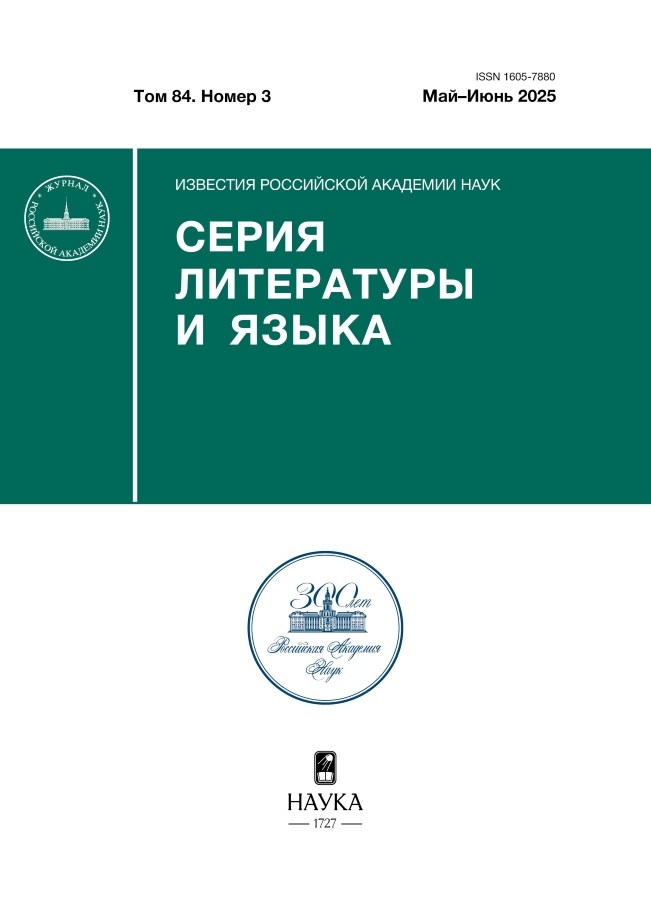Polymetrical Verse by Genrikh Sapgir (On the Example of Cycle of Poems “Memories with Angels in Kraskovo”)
- Авторлар: Azarenkov A.A.1
-
Мекемелер:
- HSE University
- Шығарылым: Том 84, № 3 (2025)
- Беттер: 37-48
- Бөлім: Articles
- URL: https://archivog.com/1605-7880/article/view/691875
- DOI: https://doi.org/10.31857/S1605788025030046
- ID: 691875
Дәйексөз келтіру
Аннотация
The article analyzes the polymetrical verse of Genrikh Sapgirʼs poetic cycle Memories with Angels in Kraskovo. It is divided into five sections. The first section examines the metrical heteromorphism in Sapgirʼs verse, concluding that he uses not meters per se, but rather lines, which form part of his metrical repertoire as “ready-made” forms, to create polymetry. The second section focuses on the tonic structure of Memoirs..., emphasizing the repetition of specific varieties of dolnik. The third section addresses the use of free verse, which appears in a limited capacity within Sapgirʼs cycle. The fourth section provides general statistics on meter and analyzes the ways in which it is combined. The fifth section explores the phonetic effects of the verse in Memoirs... in relation to its polymorphical nature. Sapgirʼs work significantly expands the possibilities of Russian metrical versification, developing a special type of polymetry that operates with stable combinations of meters, inclusions of tonic and free verse, as well as the expressive possibilities of super-short lines. An essential element in the formation of Sapgirʼs verse is the visual representation of the text, which is divided into syntagms and individual words. This leads to the emergence of a secondary rhythm, namely the rhythm of verse divisions and sound repetitions. Consequently, the same text may be perceived as metrical, tonic and free, depending on the manner of reading. Sapgirʼs proposed model of polymetry represents a transitional form of verse that resists the notion of regularity, yet functions according to a set of defined laws. Such verse may be considered a modern stage in the evolution of Russian metrical versification.
Авторлар туралы
A. Azarenkov
HSE University
Email: aazarenkov@hse.ru
21/4 Staraya Basmannaya Street, Moscow
Әдебиет тізімі
- Сапгир Г.В. Собрание сочинений: В 4 т. М.: Новое литературное обозрение, 2024.
- Кукулин И.В. Реабилитация воображения: как читать Генриха Сапгира после концептуализма? // Восемь великих: коллективная монография. М.: РГГУ, 2022. С. 389–397.
- Орлицкий Ю.Б. Стихосложение новейшей русской поэзии. М.: Издательский Дом ЯСК, 2020. 1016 с.
- Бельская Л.Л. О полиметрии и полиморфности (на материале поэзии С. Есенина) // Проблемы теории стиха. Л.: Наука, 1984. С. 99–109.
- Гаспаров М.Л. Очерк истории русского стиха. Метрика. Ритмика. Рифма. Строфика. М.: Фортуна Лимитед, 2000. 352 с.
- Холшевников В.Е. Мысль, вооруженная рифмами. Поэтическая антология по истории русского стиха. Л.: ЛГУ, 1987. 606 с.
- Орлицкий Ю.Б. Стих и проза в русской литературе. М.: РГГУ, 2002. 685 с.
- Корчагин К.М. Русский стих: цезура. СПб.: Алетейя, 2021. 520 с.
- Гаспаров М.Л. Русский стих начала XX века в комментариях. М.: Фортуна Лимитед, 2001. 288 с.
- Корчагин К.М. Гетерометрия и полиметрия Велимира Хлебникова // Язык как медиатор между знанием и искусством. М.: Азбуковник, 2009. С. 147–160.
- Плунгян В.А. Мне с каждым утром противней заученный, мертвый стих: к некоторым особенностям тонического стиха М. Кузмина // The Many Facets of Mikhail Kuzmin: A Miscellany. Bloomington (IN): Slavica, 2011. С. 43–57.
- Гаспаров М.Л. Русский трехударный дольник XX в. // Теория стиха. Л.: Наука, 1968. С. 59–106.
- Пильщиков И.А. «По ту сторону дольника»: Безударные икты и сверхсхемные ударения в русском акцентном стихе // Критика и семиотика. 2022. № 1. С. 273–318.
- Шапир М.И. Исчисление силлабо-тонической парадигмы (случай Сумарокова: «Цефал и Прокрис») // Universum versus: Язык – стих – смысл в русской поэзии XVIII–XX веков. Кн. 1. М.: ЯРК, 2000. С. 187–191.
- Шварц Е.А. Сочинения Елены Шварц: В 5 т. СПб.: Пушкинский фонд, 2002–2013.
- Шерр Б.П. Микрополиметрия Елены Шварц // Славянский стих, IX. М.: Рукописные памятники древней Руси, 2012. С. 105–116.
- Корчагин К.М. Еще раз о раннем русском свободном стихе // Корпусный анализ русского стиха. М.: Азбуковник, 2013. С. 219–242.
- Левашов А.М. Статистический анализ метрической структуры русского верлибра // Труды Института русского языка им. В.В. Виноградова. 2022. № 4 (34). С. 78–85.
Қосымша файлдар









